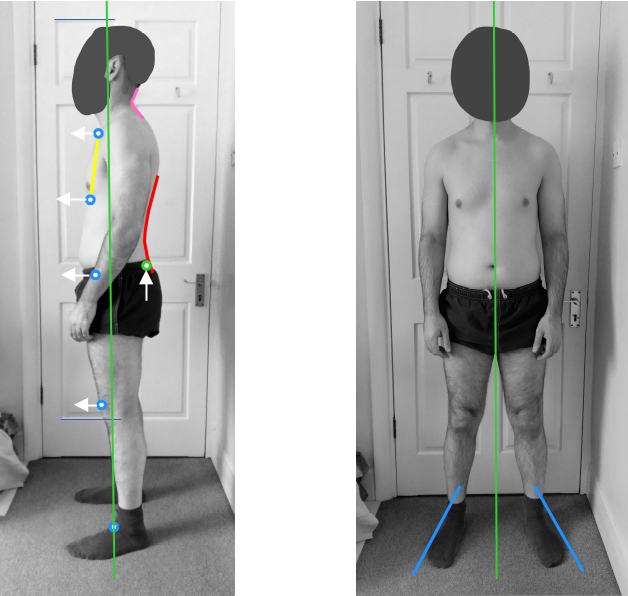Assessment context and image originals from this thread: https://www.reddit.com/r/PostureAssesments/comments/15dm9c0/my_trunk_area_is_stiff_with_my_neck_muscles/

Yes, the tension in your jaw / tinnitus could well be connected to the fact that you are jamming your head so much back and down. But let's start with the feet.
Feet not in a correct position. The blue outsteps, that are currently converging at the back should be parallel. Your stance is also quite wide, so your knees must compensate by going inward - you aren't loading the knees properly.
You also habitually place your left foot in front of the right one, but slightly. This relates to few twists through out the rest of the body, but they are not very easy to spot. However, they are present in order to satisfy your sense of equilibrium.
Knees are slightly released forward.
Iliacs (anterior superior iliac spine, the blue marker at waist height) are shifted too far forward (and down). Sacrum is lifted too high. There is a slight APT in the pelvis. The pelvis is rotating in other words.
Your sternum (yellow line) is also shifted too far forward, plus there is a rotation in the ribcage as well. You can see it by on the slant of the sternum, where the bottom is being pushed further forward than the top.
If you look closely, the rotation of the pelvis and the rotation of the ribcage are exactly opposite to each other. Pelvis goes anticlockwise, and ribcage goes clockwise. These two rotations between the parts of the upper and lower torso are "bending" the middle torso. Giving you the typical lowerback arch and the typical protruding abdomen.
Your arms are retracted too far back (to compensate for the mass shifted in the front at around your waist) and same with your head.
You are retracting your right arm further back then the left. That's why it's positioned higher, compared to the left one. You would also see it on a posterior view - your right shoulderblade will stick out more then the right.
The arch in your lowerback (red curve) means you are shortening and narrowing your torso. Slacking off your thoracolumbar fascia (same goes for your ITB). Slack fascia means you can't use it to transfer load, and that means that the load is being handled by the rest of your system. And it's not what you want.
For reference, the blue markers should all be on the green line.
This is all perfectly fixable.
You just have to learn what we all "conscious guidance and control" which means that you learn to deliberately move parts of your mechanism the way you want, rather then the way "they" want to move (habitually). Once you learn that, you can adjust your posture to more mechanically advantageous one, where your fascias get involved in supporting your torso.
That will also release the tension around your neck.